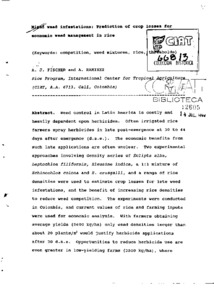Mixed weed infestations : prediction of crop losses for economic weed management in rice
Abstract
Weed control in Latin America is costly and heavily dependent upon herbicides. Often irrigated rice farmers spray herbicides in late post-emergence at 30 to 44 days after emergence (d.a.e.). The economic benefits from such late applications are often unclear. Two experimental approaches involving density series of Eclipta alba, Leptochloa filiformis, Eleusine indica, a 1:1 mixture of Echinochloa colona and E. crusgalli, and a range of rice densities were used to estimate crop losses for late weed infestations, and the benefit of increasing rice densities to reduce weed competition. The experiments were conducted in Colombia, and current values of rice and farming inputs were used for economic analysis. With farmers obtaining average yields (5600 kg/ha) only weed densities larger than about 20 plants/m2 would justify herbicide applications after 30 d.a.e. Opportunities to reduce herbicide use are even greater in low-yielding farms (3500 kg/ha), where herbicides would pay off only at weed densities larger than about 30 plants/m2. Handweeding could be an alternative to herbicide use at weed densities higher than about 25 plants/m2. Using high rice densities, providing large numbers of tillers/m2, was economical even at large weed infestations (> 100 plants/m2). Omitting the late post-emergence herbicide application would reduce weed control costs in Colombia by 28 percent.

